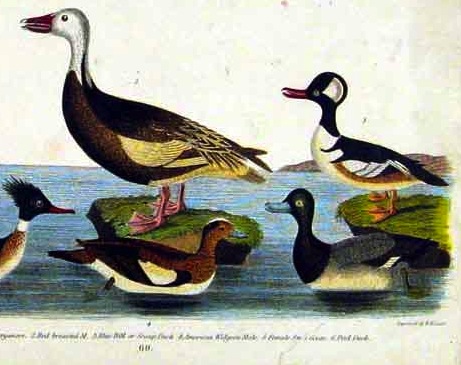
In January 1842, eighteen-year-old Spencer Fullerton Baird wrote to his brother William with a request:
[J.P.] Giraud here [in New York] has thought that there is a permanent distinction between the large & small Black heads and has commenced a description of the smaller kind as Fuligula Minor…. the small one has the black on the lower abdomen, about the anus finely undulate, while the large one has it in spots, & … the large ones have a white spot at the base of the under mandible on the chin which the other has not. These … two characters I want you to examine those in the Washington markets and let me know.
Before the late 1830s, it doesn’t appear to have occurred to anyone that the New World might in fact have two species of scaup.
In 1835, Audubon, in the Ornithological Biography, went out of his way, as so often he did, to point out the inadequacy of some of Wilson’s earlier work on the species:
The opinion, derived from Wilson’s account of the Scaup Duck, that it is met with only along our sea coasts, in bays, or in the mouths of rivers, as far as the tide extends, is incorrect. Had Wilson resided in the Western Country, or seen our large lakes and broad rivers during late autumn, winter, or early spring, he would have had ample opportunities of observing thousands of this species, on the Ohio, the Missouri, and the Mississippi, from Pittsburg to New Orleans. I have shot a good number of Scaup Ducks on all these rivers….
Wilson gave the length of his “blue bill” as 19 inches.

Audubon, thanks to his greater experience, was able to note “that specimens may be procured measuring from sixteen and a half to eighteen, nineteen, or twenty inches in length,” a significant range of variation in a duck — but he assures his reader nonetheless that scaup “seen in various parts presented no such differences as to indicate permanent varieties.”
Just a few years later, Giraud disagreed. In addition to the subtle marks William Baird was to confirm in the market stalls of Washington, D.C., Giraud had discovered that the size difference between the two apparently different species was consistent; he also showed Baird that
in the smaller ones the white band on the wing is distinctly of that color only on the secondaries & not extending to the primaries as on the large one…. the inside of the bill is dark in the small one & whitish in the large…. the small one is most tufted and has a purplish reflection on the head instead of a greenish one.
By 1844, Giraud had convinced himself that these differences rose to the level of a specific distinction, and his famous Birds of Long Island offers a full description of what he names the Lesser Scaup Duck, Fuligula minor.

What Giraud in those pre-internet days did not know was that another ornithologist had got there first. T.C. Eyton admitted in his 1838 Monograph on the Anatidae that he “entertained considerable doubts as to the propriety of making [it] into a species”; but the differences he discovered between this new bird and the familiar Greater Scaup were “constant”:
total length less; bill shorter and not so broad; nail much narrower, and not so much rounded at its sides; tarsi shorter.
And so, 175 years ago this year, Eyton described the “American Scaup” as new, under the weaselly name Fuligula affinis:
similar to the preceding species [the Greater Scaup] but with a shorter bill furnished with a narrower nail.

As late as 1922, Ludlow Griscom included the two scaup among the “birds which it is practically impossible to distinguish in life,” a remark — published in the Auk — that seems very curious indeed when we realize that almost a hundred years earlier both Giraud and Eyton had published precisely those characters birders routinely use today: head shape, bill shape, nail size, wing pattern.

But the real historic irony lurks in Audubon’s painting. There is only one species of scaup, he tells us — and then paints birds that are obviously Lesser Scaup avant la lettre.
The photograph at the top of this entry is of a flock of Aythya ducks at the Jersey shore yesterday. Can you identify them?


